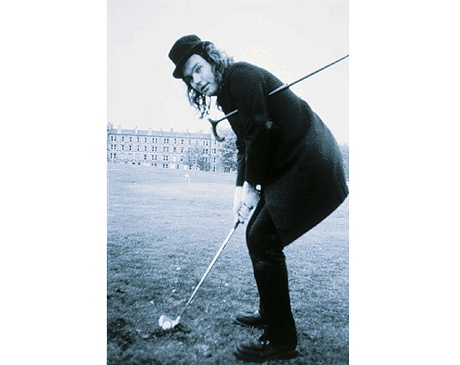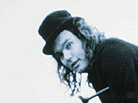Happy Outsiders from London and Scotland — investigators of the blurred borders between life and art/art and life

Why London, why Scotland ?
The exhibition ‘HAPPY OUTSIDERS’ presents the works of the artists of middle and young generation living and working in London, Glasgow, Edinburgh and Dundee. I have chosen those places for my ‘investigation’ because at the moment these are the centres of the most active contemporary art scene in the Great Britain. The project does not attempt to describe the general situation in the British art now. What is common for the artists taking part in the exhibition is the fact, that they take the contemporary outside world (‘real life’) and their own private histories as the main source of inspiration for their art. Their attitude is contemplative or ironic rather then sensational. The expression ‘happy outsiders’ used as a title is supposed to emphasise the strategy shared by these artists, which is to put oneself in a position of the observer standing on the verge of his personal histories and problems of identity, or in the position of an ironical commentator of the outside reality, an investigator of the blurred borders between life and art/art and life. Outsiders — not because they have been expelled — but the outsiders from their own will, giving away the tension for ‘stillness’ and ‘reverie’ or distanced commentary. For the Scottish artists the title has a double meaning — it refers to the strength of the Scottish art scene (especially in Glasgow) since the mid-eighties, the strength, that allowed the Scottish artists to make their own careers in the world while omitting the traditional way through London capital. It transforms traditionally negative opinion of ‘being provincial’ to the advantage of being given the possibility to start the story from scratch and not being obliged to follow old hierarchies.
Artists:
David Shrigley
Hilary Lloyd
Ross Sinclair
Chad McCail
Lucy McKenzie
Christine Borland
Graham Gussin/Jeremy Millar
Ryan Doolan
Darren Almond
David Blamley i Paul O’Neill
Jeremy Deller
Mark Leckey
Runa Islam
Roderick Buchanan
Simon Starling
Martin Boyce
Liam Gillick
Michael Wilkinson
Mary Redmont
Toby Paterson
Nathan Coley
Cathy Wilkes
Alex Frost
Curator: Magda Kardasz

‘Crudely speaking, we see a shift from artists as middle-class professionals (bohemian by self-proclamation) committed to art as an activity that seems self-justificatory, to artists happier in their marginality and who used such a position to research and comment on their world and lives. (…) We are looking at a shift from art as a worthy thing in itself to art as something more dependent on everyday personal life.’
Tony Godfrey
‘British Art and The British Art Show 1976-2000’
Since the beginning of the 1990s the British art scene has become broadly recognised as very lively and having its own powerful image. The phenomenon of the ‘yBa’ (young British art/artists) — group of the artists, with its key figures such as: Damien Hirst, Rachel Whiteread, Sarah Lucas, Douglas Gordon, Sam Taylor-Wood, Mat Collishaw, Fiona Banner, Gillian Wearing, Mona Hatoum, Chris Ofili and Gary Hume, active as a specific coterie from 1988 with the famous exhibition Freeze at the London Docklands till 1997 and the scandalous show Sensation at the Royal Academy in London, made the visual art a part of pop-culture and a field of interest for media. The artists achieved the status of genuine stars (also in terms of financial success) while appearing in the colourful magazines on equal rights with other celebrities — like Posh Spice and David Beckham, Lady Diana story, top models and Dolly sheep images. Those melting tendencies of the contemporary world are aptly illustrated by a statement of Liam Gallagher, the Oasis leader, who in 1997 declared that his band is more popular than Jesus). The phenomenon of ‘yBa’ has been many times analysed in a broaden cultural or socio-political context (frequently as a result of Tony Blair's ‘Cool Britannia’ policy). Visual culture became to be perceived as ‘useful mean of reading the cultural climate.’ Through the last decades because of fading of the values of modernism with it's belief in the progress in art and an obligation to create an art object as a special kind of commodity and recent development of the digital and virtual culture the role of the cultural practice within the society has changed. The people began to read the culture in new and different ways.(1) The artists born and brought up in the 1970s and 1980s faced the same problem yet from a perspective of the creators of cultural facts. In most cases they were undertaking the ideas initiated by Conceptual artists such as: emphasising the crucial role of language in all visual experience and opening up to philosophy, linguistics, social sciences and popular culture. In the 1990s the Conceptual art has reached its apogeum — became the synonym for the far-out or crazy for its showmanship and outrage, used as an artistic strategy or — according to the other opinion — as a mean to get the media attention. This decade was awashed with the works looking similarly to the ones produced 30 years ago — reminding of minimal art objects, ready-mades, Conceptual documentation, word pieces, interventions. They were much better done then in the 1960s, but normally to less point — in so far as the ideological context and medium are not questioned to the same degree.(2) On the other hand one should remember that the utopian goals of the 1960s have been negatively verified already some time ago… In spite of some similarities, it is not concept that matters so much — it is rather sensory experience or visual qualities. For this new generation artistic practice means reacting for popular culture and for the artistic past (for example the works of the artists exhibiting at the Sensation show have been called ‘convulsions of an outraged romanticism,’ compared to the works of their colleagues from the hundred years before — Symbolists or the closer ones — Minimalists, Fluxus and Pop artists). Their main goal however was searching for new areas of work, documenting the spirit of the time (Zeitgeist).
There are also other areas, in which the legacy of Conceptualism has developed — these are: project-directed works and ongoing concern with the everyday and interpersonal communications.(3) When you ask any young artist: ‘What are you currently working on now?’, in most cases you would hear in reply: ‘I am preparing a new project.’, instead of: ‘I am painting, working on my new sculpture, making installation etc.’ — in other words: ‘I am making an art work.’ Artists and their projects. Creating as a process, in which investigation of some topic or field is important per se, not only as searching for the source of inspiration, but rather enjoying collecting information that might lead to the act of creation (which finally results with the appearing of piece of art or decision to share with viewer the evidences of your detectivistic work). This decision also differs from the Conceptual dilemma of dichotomy between form and concept, which was disguised as a false one already some time ago. The key aspect of a Conceptual art today, would, thus, lie not in objects and spaces, but in communality, and an emphasis on communication and on how people behave.(4)
This is the situation that the artists taking part in the exhibition ‘Happy Outsiders’ shared in the beginning of their career (some) or observed from the safe position of the outsider (because of having different attitude towards art or simply being too young to join the club). There is a general opinion on the current situation of the British art, that it is in the state of flux. If the language and subject matter of yBa was loosely defined as social, witty, sexual, morbid and largely
a-political, then the momentum of those concerns would eventually fall away to allow the exploration of a new sensibility. (…) Rather than the tension of a compressed experience of time, there would be a gradual reduction of cultural intensity — an appeal, beyond the social rituals of the Millennium, to reflection and meditation.(5) This attitude is totally different to the one that ruled for the last decade (‘professionalism, personality cults, commodification’). Artistic practise now reflects a sense of being apart, enquiring, serious, politically engaged and more reactive to issues of craft. (…) One common theme, that runs through their work is a form of poeticised ethnography, in which behaviour, the experience of environment and cultural marking are examined from meditational. investigative or absurdist standpoint.(6)
(1) Michael Bracewell, Quiet Science, in: Beck’s Future ICA, London 2000
(2) Tony Godfrey, fragments from the chapter Controversies and Contexts in Recent Art, in: Conceptual Art, Phaidon Press Limited, London 1998
(3) Ibidem
(4) Ibidem
(5) Michael Bracewell, op. cit.
(6) Ibidem


